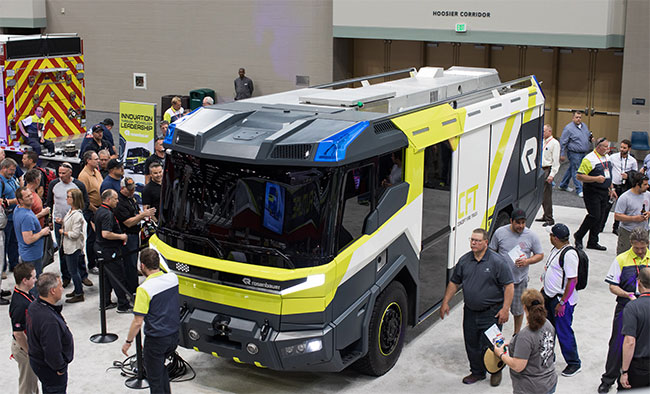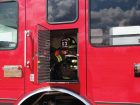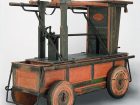
Features
Looking ahead
What will the fire truck of the future look like?
October 30, 2019
By
Laura Aiken
 Rosenbauer will be showcasing its electric prototype in 2020. Photo: Rosenbauer
Rosenbauer will be showcasing its electric prototype in 2020. Photo: Rosenbauer
Close your eyes and picture…wait – don’t do that. How can you see the rest of this article with your eyes closed? And you’re going to want to read the rest of this. Let me start again. Keep your eyes open, and picture your fantasy fire truck 50 years down the road. What has it morphed into? Is it flying or rising up out of traffic on spidery legs of steel? Is it self-driving? Does it run on compost and float in an indestructible bubble? The future is fun to imagine, and that cognitive projection drives us here, there and everywhere until we figure out where we are going. This brings us to the crux of our story: Where are the innovations in fire apparatus today taking us in the not too distant tomorrow?
There’s a familiar adage spun a million ways; it’s essence being to know where you are going, you need to know where you have been. Let’s take a very short peek at the days of yore before hearing from a wealth of industry experience on where fire truck technology looks to be headed.
■ Step into my Newsham…
Richard Newsham, a button maker from London, made a big improvement to the fire engine with his design that was awarded a patent in 1721, stated the Colonial Williamsburg Museum website. Newsham’s hand pump fire engine could pump water in a continuous stream, draw from a reservoir, was operated by hand or foot and could spray water at 125 gallons per minute (picture on page 12).
The suction engine was introduced in 1822, cited the Pioneer Auto Museum.The suction engine gave firefighters the ability to take water from a concentrated area. This preceded the addition of horses to pull the engine, which drastically improved response times when they came along.
Apparatus made strides upward when Daniel Hayes invented the aerial ladder fire truck in or around 1868, as reported by The Virtual Museum of the City of San Francisco. The San Francisco Fire Department was the first to put it into use and purchased it for $3,000 USD.
That’s the short peek; just a smidgen of history to show a few highlights of the pace at which apparatus progressed up to the Industrial Revolution and onwards. In short, fire trucks have come a long way from the horse drawn days! We’ll now look ahead by hearing from the minds of three industry veterans on where the technology is headed and the current and evolving challenges from their perspective.
■ Brad Petrie, internal sales manager at Fort Garry Fire Trucks
Brad Petrie, the internal sales manager at Fort Garry Fire Trucks, just marked his 20th year with the company. In his role, he sees all the bids nationwide, all the trucks people are tendering and is involved in every step with Fort Garry’s customers, from conception to delivery.
Petrie named finances first as one of the ongoing challenges for fire departments in apparatus procurement, as there are many volunteer departments and it will always be tricky getting funding in place for an apparatus ranging from as low as about $350,000 to as high as $900,000, depending on what they need. As far as those needs go, in the past five years, Petrie said he’s seen a lot more awareness of firefighter safety.
“In the last few years, they are asking for clean cabs in fire trucks; a spot to put their turnout gear after it gets covered in all the soot and all the bad chemicals. They don’t want it affecting a firefighter’s health.”
Looking ahead, perhaps another 20 or 30 years, Petrie said hybrid fire trucks or maybe even autonomous fire trucks could be on the road. Technology is changing, but he doesn’t think we’ll do away with aerial devices in our lifetime he said, in referencing recent news of a team of Southern Alberta Institute of Technology (SAIT) students who developed the concept for Skywalker, an aerial emergency rescue operation vehicle. That being said, he noted that looking to the future, you never know.
What Petrie is surer of is the SAM system or others like it taking off. SAM manages the pump waterflow from a touchscreen, freeing up a person for other tasks. The system integrates all of the pump controls, replacing the pressure governor and opening and closing valves based on settings. It’s also designed to get the water moving fast.
As touchscreens continue to touch down in myriad industries, green initiatives also continue to dominate. Petrie said electric fire trucks will take off eventually.
“Not soon, but the whole industry in vehicles — you can see it’s all shifting to that and quickly.”
Fort Garry’s technical director Gordan Draskovic is interested in a co-op to build an electric fire truck, Petrie said and he has been prodding the sales team to talk to their customers about them. He sees Draskovic’s direction as a large indicator of things to come. The battery innovation will need to catch up to make it a reality, as currently it’s a challenge to have the power to drive the pump as well as drive the truck. Petrie remarked there is testing on electric heavy duty trucks going on in Europe that is also indicative of the direction things are headed.
Fort Garry’s latest innovation addresses that big fundamental question of finances. The company is introducing its Bronto All Rounder at FDIC in Indianapolis in 2020. Fort Garry’s goal was to take an articulating aerial device by Bronto that would normally run about $2 million and bring the price down to about $1 million by creating an economical version. The truck is built on a commercial instead of custom chassis to help reduce the price, and is also built on a single axle to keep it maneuverable for small towns and the northern areas, said Petrie. Fort Garry will also be partnering with someone to produce a SAM demo truck for FDIC and the rest of the 2020 trade show circuit.
Petrie is also seeing innovation and changes in warning and LED lights. Now that Ontario has opened up blue and red warning lights to the fire service, Fort Garry is seeing an uptick in requests for these colours for fire. For 2020, Petrie said to watch out for lights with dimming features to catch a lot of buzz. As an example, he mentioned Whelen’s situational adjustment lighting systems that automatically dim or brighten as needed in day or night. This option will keep firefighters and civilians safer because sometimes the lights on a truck are too bright and blinding to those coming on to the scene.
■ John Witt, president of Safetek Emergency Vehicles
John Witt began his nearly 40-year career in 1980 with Pierreville Fire Trucks in Quebec, and brought Bronto Skylift to the North American market in 1985. After leaving Bronto, he started Safetek Emergency Vehicles Ltd. in 1993, the exclusive Spartan ER dealer in Canada. Over this almost four-decade span, Witt said fire apparatus have become much more complicated, sophisticated and reliant on electronics. Fire apparatus design is being challenged by property developers and municipal planners who want narrower roadways to make room for higher density building footprints, which puts restrictions on the size and turning radius of apparatus. In addition, departments are specifying more compact Quick Response (medical) and Special Operations units that can serve multiple purposes and reduce the wear and tear on the larger apparatus.
On the subject of electrically driven fire trucks, he said Safetek has been asked about them. Cost and a battery technology remain stalwart impediments in the march towards widespread electric fire truck adoption, but he pointed to the fact that one of Australia’s larger departments is planning on testing a hybrid electric apparatus in 2020.
On the green front, Safetek’s current environmental initiative is its Green Power auxiliary power unit (APU). This anti-idle technology runs similar to a diesel generator and shuts down the main engine while idling. The APU has an independent alternator to operate all low voltage electronics and a parallel HVAC system.
Witt said the APU feature is becoming more popular and Safetek has delivered over 100 Green Power fire apparatus across Canada to both large and medium sized fire departments that saves diesel fuel consumption, GHG emissions, noise and engine hours on the prime mover engine. Safetek’s next step for Green Power is introducing a lithium ion battery system for a zero-idle feature. (Of note on the subject of lithium batteries: this year’s Nobel Prize in Chemistry rewarded the development of the lithium-ion battery by recognizing John B. Goodenough, M. Stanley Whittingham and Akira Yoshino).
In terms of the hot topic of cleaner cab design and firefighter cancer prevention, this is something Safetek has been promoting. Witt said some departments have already designed their new apparatus with this feature and many more are now are looking at it, but it will take the stakeholders to adopt a whole package of behaviours that must be followed to keep not only the firefighters, but mechanics and anyone else around a fire truck free from contaminants.
“I don’t think anybody’s got it all figured out yet — how to do it. It’s a trend and we’re acknowledging it and we’re working with several FD’s looking at it for their next order of trucks, but we have other FD’s that aren’t and are asking how much does it cost; is it worth it?”
Spartan chassis, for example, introduced a number of cleaner cab features including storage for SCBAs, Ease To Clean cab interior surfaces and an advanced filtration system incorporating a HEPA high efficiency integration system to mitigate cab toxins.
Cab safety is also a priority now and for the future. Witt said the Spartan chassis offers an Advanced Protection System that provides frontal and side impact air bag protection. The 360-degree camera with blind spot detection has been a boon for firefighter safety and liability by providing the driver with a complete view of the apparatus.
And what does Witt see for the future? Keep and eye out for high-tech. Manufacturers are already offering systems that not only control the pump panel from a tablet, but offer parallel systems that can diagnose and manage breakdowns remotely.
“Fire departments unfortunately don’t have that redundancy benefit that you see in commercial aircraft, so firefighters want the ability to troubleshoot and fix an apparatus on scene. This is why we see some resistance to these sorts of innovations, but with the level of investment manufacturers are putting in and a new generation of firefighter, we don’t see this trend going away any time soon.”
He said that GPS and in-truck Wi-Fi connections are becoming popular as well as traffic light controllers and systems that use popular apps such as Waze to notify motorists of nearby emergency vehicles.
He said he also sees more higher reaching yet compact aerial devices to reach upper floors of buildings that go beyond the traditional 30M as a future trend, and “not just vertically, but articulating to provide up and over reach. These types of trucks also offer more maneuverability in tighter city streets versus a straight stick offering the same length.”
In the business of buying and selling, he said he is experiencing more single-source multi-year agreements to allow departments to “standardize” their fleet for not only maintenance but training and use of same.
“Our customers are also looking for full service local dealers with comprehensive 24/7 parts and service support, something that will be of increasing importance as the apparatus becomes more complicated and electronic. Downtime is the enemy of the modern FD fleet, and they are looking for a “partner” to keep that truck in service from delivery to retirement.”
■ Scott Oyen, CEO of Rosenbauer South Dakota
Scott Oyen started in the industry with Rosenbauer in 1991, and worked multiple facets of the business over his nearly 30-year career. As CEO of Rosenbauer South Dakota, he described the same increasing complexity of trucks seen by Witt at Safetek. The options for customization are ever-increasing and how that technology is integrated — how that complexity is managed — is an evolving challenge for the fire industry and departments in respect to service and option content.
Going forward, Oyen said he sees opportunity in green initiatives. There is a demand coming for electrically powered vehicles, he said, and how that technology is adapted to suit the fire service will be challenging.
“For a completely electric driven truck, how do we get enough battery reserve power to power a pump while fighting a fire, for example, or how do we work aerial ladder devices with electric power? There’s a finite amount of electrical power there, how do we manage that without running out on scene?”
Oyen said electrical power will be an innovation that takes off. Rosenbauer is demonstrating a prototype throughout North America in 2020. Right now, electric is certainly more expensive, but he said the cost will come down with demand. However, the electronic options that have been introduced in recent years are part of driving up the cost of fire trucks today considerably. Smaller departments will likely need to keep their option content to the basic needs to stay in budget.
Cancer is also a high priority for Rosenbauer to address now and down the road, he said, indicating that keeping the cab clean of carcinogens will be a major issue going forward. At the 2019 FDIC show in Indianapolis, Rosenbauer exhibited a new cab filtration system and Oyen said there’s been a lot of interest in that, and that the company can retrofit existing pumpers with the technology. He said he believes that clean cab technology will be accessible to all departments in the future.
“It’s new enough that there’s really no standard set by the industry, so the standard we designed to meet is actually in a different industry where clean air is required. I see eventually someone developing a standard for fire service. Most departments now launder bunker gear after each fire scene, and they are also doing a gross decon on scene, then washing the bunker gear after the call is over, so practices are changing at a widespread level.”
■ What do you see?
Well, our words here are done. You can close your eyes now and imagine your fantasy future fire truck. I’d love to hear what you see! Send me an email at laiken@annexbusinessmedia.com if you want to share your thoughts.
Print this page


